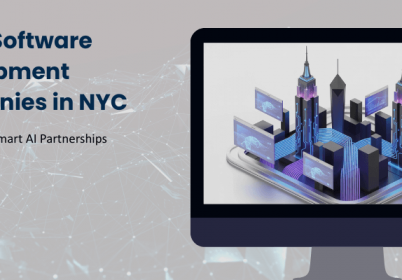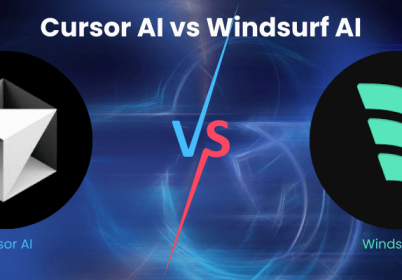Top Benefits of AI: How Artificial Intelligence is Transforming Businesses and Everyday Life

Table of Contents
Artificial intelligence continues to reshape industries across the global economy with remarkable speed and transformative impact. The benefits of AI extend beyond simple automation, offering powerful capabilities that can revolutionize operations for organizations of every size. Companies implementing AI solutions gain competitive advantages through enhanced operational efficiency and more informed decision-making based on comprehensive data analysis. The benefits of AI also create improved customer experiences through deeper personalization and significantly faster response times to inquiries and issues. From advanced healthcare diagnostics to precision manufacturing quality control, AI technologies deliver measurable improvements across diverse business functions. This guide explores the key benefits, practical limitations, and essential ethical considerations surrounding artificial intelligence in today’s rapidly evolving business landscape.
Key Takeaways:
- AI transforms businesses and daily life by boosting decision-making, operational efficiency, customer personalization, cybersecurity, healthcare outcomes, marketing strategies, and competitive intelligence.
- Applications span industries and functions — including marketing, finance, HR, manufacturing, healthcare, supply chain, and customer service — delivering measurable efficiency, quality, and innovation gains.
- Cost reduction and resource optimization come from predictive maintenance, energy savings, fraud prevention, demand forecasting, workflow automation, and intelligent budget allocation.
- Challenges and limitations include high costs, data dependency, algorithmic bias, integration issues, explainability concerns, privacy risks, and need for ongoing updates to prevent model drift.
- Responsible AI adoption demands ethical frameworks, transparency, human oversight, and realistic ROI expectations, with small businesses starting affordably via targeted SaaS solutions.
Table of Contents
What is AI?

Artificial intelligence encompasses computer systems designed to perform tasks that typically require human intelligence and judgment. These sophisticated systems analyze enormous datasets to identify meaningful patterns and make predictions without explicit programming for each possible scenario. Modern AI applications utilize advanced machine learning algorithms that continuously improve performance through exposure to new information and feedback. Business applications of AI now span across marketing, finance, human resources, customer service, and complex supply chain operations.
Marketing teams leverage AI for precise customer segmentation and delivering personalized content based on observed behavioral patterns. Financial institutions implement robust AI systems for fraud detection and risk assessment through analysis of subtle transaction anomalies. Human resources departments utilize AI-powered tools for efficient resume screening and matching qualified candidates against specific job requirements. Customer service operations deploy intelligent chatbots and virtual assistants to handle routine inquiries while routing complex issues to appropriate specialists. Supply chain managers employ sophisticated AI for accurate demand forecasting and inventory optimization through comprehensive historical data analysis.
The fundamental power of AI revolves around recognizing subtle patterns that humans might easily miss within massive, complex datasets. Natural language processing enables machines to understand and generate human language for increasingly natural communication applications. Advanced computer vision technology allows systems to interpret and categorize visual information from diverse images and video content. Predictive analytics capabilities help businesses anticipate emerging trends based on historical patterns and current market signals. These technologies collectively form the foundation for transformative AI applications across industries and critical business functions.
Top 10 Benefits of AI for Your Business
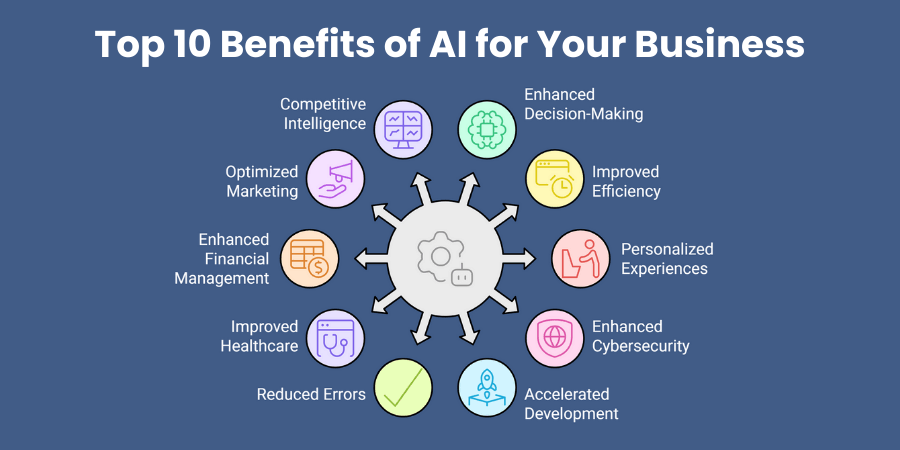
1. Enhanced Decision-Making
AI systems analyze vast amounts of structured and unstructured data to identify patterns invisible to even experienced human analysts. Business leaders receive actionable insights based on comprehensive analysis rather than limited samples that might miss crucial trends. Decision-making processes become more objective through systematic elimination of human cognitive biases that can distort judgment. Organizations gain meaningful competitive advantages through faster identification of emerging market trends and previously hidden business opportunities. AI-powered predictive analytics enable truly proactive strategy development rather than reactive approaches that often miss critical market shifts.
2. Improved Operational Efficiency
Intelligent automation of repetitive tasks frees valuable employee time to focus on higher-value strategic activities requiring human creativity. Manufacturing operations achieve greater precision and consistency through AI-controlled production processes that maintain quality standards around the clock. Administrative workflows benefit from intelligent document processing and automated data entry systems that reduce errors and processing time. Customer service operations maintain continuous availability through AI-powered chatbots handling routine inquiries without human intervention. Supply chain optimization occurs through sophisticated AI analysis of inventory levels, supplier performance metrics, and accurate demand forecasting.
3. Personalized Customer Experiences
AI enables dynamic content customization based on individual customer preferences, past behaviors, and current context signals. E-commerce platforms deliver highly relevant product recommendations that significantly increase conversion rates and average order values over time. Marketing campaigns achieve measurably higher engagement through AI-optimized messaging tailored to specific audience segments and their demonstrated interests. Customer service interactions improve through intelligent systems that recognize customer history and anticipate needs before they’re explicitly stated. Financial services firms provide truly customized advice based on individual financial behaviors and specific personal goals.
4. Enhanced Cybersecurity
Advanced AI systems continuously monitor network traffic patterns to detect subtle anomalies that may indicate potential security threats. Security teams receive early warnings about suspicious activities before breaches occur, enabling proactive threat mitigation rather than reactive damage control. Authentication systems utilize sophisticated AI for facial recognition and behavioral biometrics to prevent unauthorized access while reducing friction for legitimate users. Organizations benefit from automated threat intelligence gathering across global security databases that identify emerging attack patterns. AI-powered security systems adapt to evolving threats through continuous learning from new attack methodologies observed across the digital landscape.
5. Accelerated Product Development
Research teams leverage AI to identify promising compounds in pharmaceutical development that human researchers might overlook among countless possibilities. Product designers utilize generative AI to explore innovative design variations that extend beyond conventional human imagination and established patterns. Manufacturing prototyping accelerates through sophisticated AI simulation of product performance under various environmental and stress conditions. Market research benefits from AI analysis of consumer sentiment across diverse social media platforms and review sites. Quality assurance improves through AI detection of subtle product defects invisible to human inspectors even under magnification.
6. Reduced Human Error
Critical processes gain remarkable reliability through AI systems that maintain consistent performance without fatigue or attention lapses. Financial operations minimize costly mistakes through automated reconciliation and fraud detection systems that flag discrepancies immediately. Healthcare providers reduce diagnostic errors through AI analysis of medical images and patient data that identifies subtle patterns. Manufacturing quality control improves through computer vision systems that inspect every single product unit with consistent precision. Data entry accuracy increases dramatically through intelligent document processing and validation systems that verify information across multiple sources.
7. Improved Healthcare Outcomes
Medical professionals access powerful AI-powered diagnostic tools that identify subtle patterns in complex patient data across multiple systems. Treatment plans become truly personalized through comprehensive analysis of individual patient characteristics, medical history, and response patterns. Drug discovery accelerates through sophisticated AI simulation of molecular interactions and potential therapeutic effects across diverse patient populations. Patient monitoring systems detect early warning signs of deterioration in hospital settings before human observers notice visible symptoms. Population health management improves through analysis of community-wide health trends and specific risk factors affecting different demographic groups.
8. Enhanced Financial Management
Financial institutions detect fraudulent transactions through real-time pattern analysis of account activities compared against established behavioral baselines. Investment strategies benefit from AI analysis of market trends, economic indicators, and subtle correlations between seemingly unrelated factors. Credit decisions become more accurate through comprehensive analysis of applicant financial behaviors beyond traditional credit scoring models. Insurance companies assess risk more precisely through AI analysis of multiple factors that human underwriters might overlook. Regulatory compliance improves through automated monitoring of transactions against current requirements that update in real time.
9. Optimized Marketing Strategies
Marketing teams identify high-potential customer segments through sophisticated AI analysis of behavioral patterns across multiple interaction channels. Campaign performance improves through real-time optimization of messaging, visual elements, and channel selection based on audience response. Content creation accelerates through AI-assisted writing and image generation tools that maintain brand voice while increasing production capacity. Customer journey mapping becomes more accurate through detailed analysis of touchpoint interactions and emotional response indicators. Social media monitoring provides actionable insights through sentiment analysis and early trend identification before mainstream awareness.
10. Competitive Intelligence
Organizations gain valuable market insights through AI analysis of competitor activities, product launches, and emerging industry trends. Product pricing strategies optimize through dynamic analysis of market conditions, consumer behaviors, and competitive positioning in real time. Strategic planning improves through AI-powered scenario analysis and predictive modeling that considers multiple possible market developments. Talent acquisition becomes more effective through analysis of workforce trends and skill availability across different geographic regions. Innovation opportunities emerge through AI identification of unmet customer needs and market gaps that traditional research might miss.
Limitations of AI
Despite impressive capabilities, current AI systems struggle with understanding nuanced context and subtle emotional cues in human communication. Machine learning models require extensive high-quality data, creating significant barriers for organizations with limited or poorly structured datasets.
Implementation costs remain substantial, particularly for small and medium-sized businesses facing tight budget constraints and competing priorities. Technical expertise requirements create adoption challenges for organizations without specialized AI talent or access to qualified consultants. Integration with legacy systems often presents unexpected compatibility issues that delay implementation timelines and increase project costs.
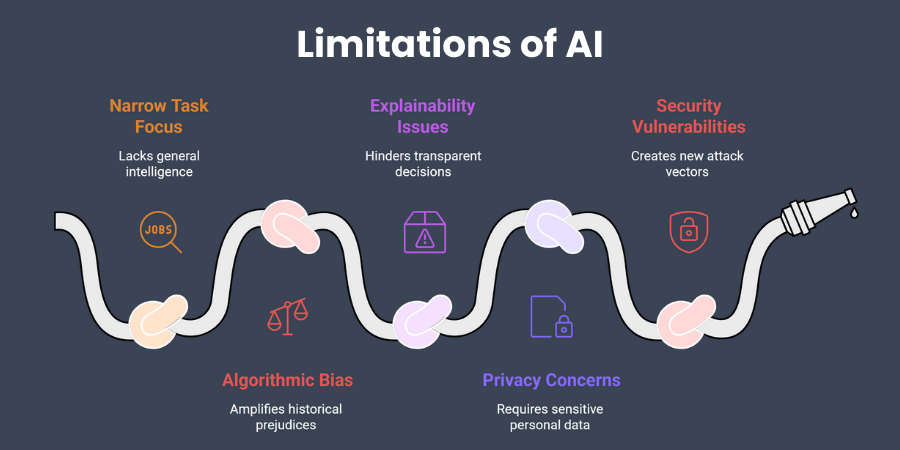
Common AI limitations include:
- Excelling at narrow tasks rather than demonstrating general intelligence capabilities across diverse situations
- Algorithmic bias when training data contains historical human prejudices that get amplified through machine learning
- Explainability issues in regulated industries requiring transparent decision-making processes for compliance and auditing
- Privacy concerns from AI systems requiring access to sensitive personal data for effective operation
- Security vulnerabilities that may create new attack vectors for increasingly sophisticated malicious actors
The technology requires ongoing maintenance and regular updates to maintain performance as business conditions and data patterns change. Model drift occurs when real-world conditions evolve beyond the patterns present in original training data, reducing accuracy over time. Dependency risks emerge when critical business processes rely heavily on AI systems without adequate fallback procedures. Regulatory compliance becomes increasingly complex as AI governance frameworks continue to evolve across different global jurisdictions. Return on investment timelines often extend significantly longer than initially projected during enthusiastic implementation planning phases.
Ethical Considerations of AI
Organizations must proactively address potential bias in AI systems that could unintentionally perpetuate historical discrimination patterns through automated decisions. Transparency requirements necessitate clear communication about when customers interact with AI versus human representatives across all touchpoints. Privacy protection demands careful handling of personal data used for AI training and operational decision-making throughout the data lifecycle. Accountability frameworks must establish clear responsibility for AI-driven decisions affecting stakeholders, especially in high-impact situations. Human oversight remains essential for consequential decisions despite increasing automation capabilities and pressure for operational efficiency.
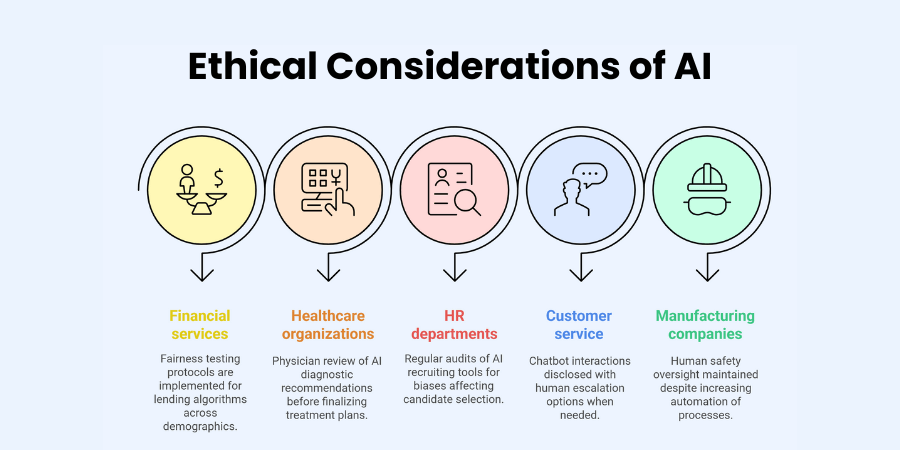
Industry-specific ethical implementations include:
- Financial services implementing rigorous fairness testing protocols for equitable lending algorithms across diverse demographic groups
- Healthcare organizations maintaining physician review of AI diagnostic recommendations before finalizing patient treatment plans
- HR departments conducting regular audits of AI recruiting tools for potential biases affecting candidate selection
- Customer service operations clearly disclosing chatbot interactions with straightforward human escalation options when needed
- Manufacturing companies maintaining human safety oversight despite increasing automation of complex production processes
The IEEE Global Initiative on Ethics of Autonomous and Intelligent Systems provides comprehensive ethical guidelines for responsible development. Microsoft’s Responsible AI principles emphasize fairness, reliability, privacy, inclusivity, transparency, and clear accountability throughout the AI lifecycle. Google’s AI principles explicitly prohibit applications causing overall harm or weapons development while promoting beneficial applications. The European Union’s Ethics Guidelines for Trustworthy AI establish specific requirements for human agency and appropriate oversight mechanisms. Organizations increasingly appoint dedicated ethics officers specifically focused on responsible AI implementation and comprehensive governance frameworks.
How AI can help in Cost Reduction and Resource Optimization
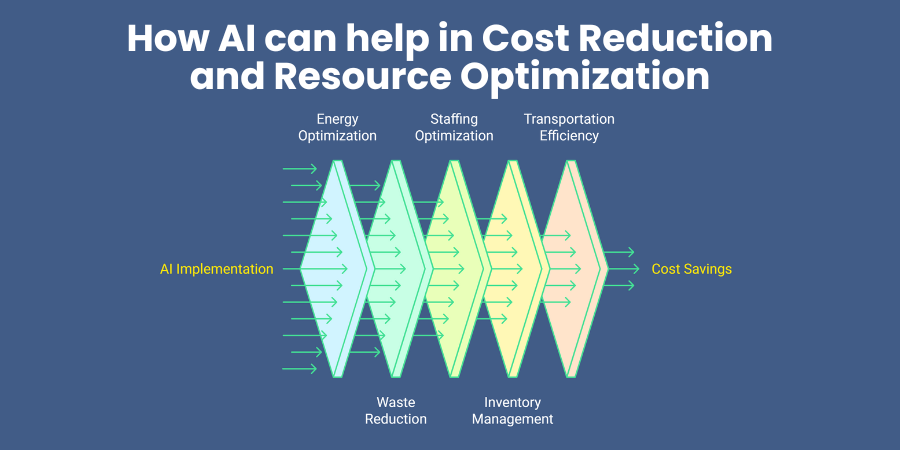
AI delivers significant cost reductions through:
- Energy consumption decreases via AI-optimized building management systems that adjust based on occupancy patterns
- Manufacturing waste reduction through predictive maintenance preventing expensive equipment failures before they occur
- Healthcare staffing optimization through analysis of patient admission patterns and resource allocation needs
- Retail inventory cost minimization through accurate demand forecasting that prevents overstocking and stockouts
- Transportation fuel savings through AI-optimized routing and load planning across complex distribution networks
Cloud computing resources scale dynamically based on AI prediction of processing needs throughout the day, eliminating wasteful overcapacity. Customer service operations reduce costs through intelligent chatbots handling routine inquiries without human intervention while maintaining satisfaction levels. Marketing budgets yield greater returns through AI allocation of spending to highest-performing channels and campaigns based on real-time performance. Supply chain efficiency improves through AI-powered vendor selection and continuous performance monitoring systems that identify optimization opportunities. Administrative costs decrease through intelligent automation of document processing and data entry tasks that previously required manual handling.
Financial institutions reduce fraud losses through sophisticated real-time transaction monitoring and risk scoring systems that flag suspicious activities. Insurance companies optimize claim processing through automated assessment of straightforward cases while routing complex claims to specialists. Telecommunications providers reduce network maintenance costs through predictive analysis of potential failure points before service interruptions occur. Utility companies optimize grid operations through AI balancing of supply and demand fluctuations across different consumption patterns. Hospitality businesses reduce food waste through AI-powered inventory management and meal planning systems based on reservation patterns.
Conclusion
The benefits of AI extend across virtually every aspect of modern business operations and strategic planning processes. Organizations implementing thoughtful AI solutions gain significant advantages in operational efficiency, decision quality, and delivering exceptional customer experiences. Responsible AI adoption requires carefully balancing technological capabilities with ethical considerations and appropriate human oversight mechanisms throughout the implementation process. Strategic planning for AI implementation must include clearly defined objectives, appropriate technology selection, and comprehensive change management approaches. The most successful organizations view AI as an augmentation of human capabilities rather than a complete replacement for human judgment.
Ethical frameworks and robust governance structures represent essential components of any comprehensive AI strategy in today’s business environment. Organizations must establish clear guidelines for data usage, algorithm transparency, and decision accountability before deployment begins. The current limitations of AI technologies necessitate realistic expectations and appropriate human involvement in critical decision points. Continuous monitoring and refinement of AI systems ensure ongoing alignment with evolving business objectives and ethical standards. With thoughtful implementation guided by clear values, artificial intelligence creates substantial business value while maintaining alignment with organizational principles and societal expectations.
Frequently Asked Questions
What industries benefit most from AI implementation?
Healthcare, financial services, manufacturing, retail, and logistics currently demonstrate the most substantial and measurable AI benefits. Healthcare organizations leverage diagnostic assistance and treatment optimization through sophisticated patient data analysis across multiple systems. Financial institutions implement fraud detection and algorithmic trading systems with clearly measurable return on investment and risk reduction. Manufacturing companies achieve quality improvements and cost reductions through predictive maintenance and automated inspection systems. Retail businesses enhance customer experiences through personalized recommendations and inventory optimization that increases sales while reducing costs. Logistics operations improve through route optimization and demand forecasting capabilities that maximize resource utilization.
How long does it typically take to see ROI from AI investments?
Return on investment timelines vary significantly based on implementation complexity and organizational readiness factors. Simple automation applications often deliver measurable returns within 3-6 months through direct cost reduction and efficiency improvements. Customer experience enhancements typically show meaningful results within 6-12 months through improved satisfaction metrics and increased retention rates. Complex predictive analytics implementations may require 12-18 months before delivering substantial financial returns across the organization. Organizations with clear objectives, quality data resources, and strong change management typically experience faster ROI timelines. Regular measurement against established key performance indicators remains essential for tracking AI investment returns effectively.
What skills do employees need to work effectively with AI systems?
Essential skills for working effectively with AI systems include:
- Data literacy to understand and thoughtfully interpret AI-generated insights within business context
- Critical thinking to appropriately question AI recommendations rather than accepting outputs without evaluation
- Domain expertise to provide valuable context and judgment alongside AI capabilities
- Basic technical understanding to communicate effectively with AI development teams about requirements
- Adaptability and continuous learning mindsets to navigate rapidly evolving technological capabilities
Organizations should invest in comprehensive training programs that develop these complementary human skills alongside AI implementation.
How can small businesses benefit from AI without large technology budgets?
Small businesses can leverage pre-built AI solutions available through affordable software-as-a-service subscriptions with predictable monthly costs. Customer service capabilities improve through implementation of basic chatbots requiring minimal technical expertise but delivering immediate value. Marketing effectiveness increases through accessible AI-powered analytics and campaign optimization tools that maximize limited budgets. Operational efficiency benefits from readily available document processing and workflow automation solutions that reduce administrative burdens. Small businesses should start with focused applications addressing specific pain points rather than attempting comprehensive enterprise-wide implementations. Gradual adoption allows for building internal expertise while managing investment levels appropriately for limited resources.
Shaif Azad
Related Post
Best Leonardo AI Alternatives in 2025: Find the Right AI Art Tool for Your Needs
New York City has rapidly emerged as one of the world’s most dynamic hubs for technology...
Top AI Software Development Companies in NYC: Your Guide to Smart AI Partnerships
New York City has become one of the most exciting hubs for technology and artificial intelligence....
Cursor AI vs Windsurf AI: The Future of AI-Powered Code Editors in 2025
The landscape of software development has undergone a remarkable transformation in 2025, with AI-powered code editors...


